Ann Ronald
(University of Nevada Press)
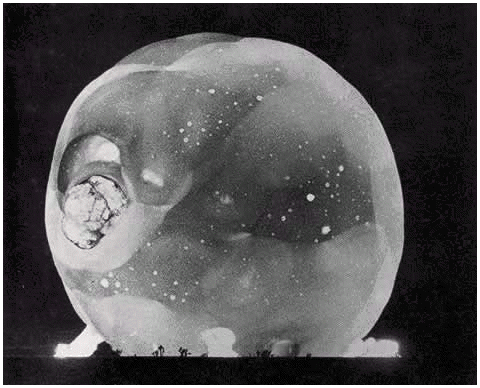
For example, up until the middle of the last century, international manslaughter was mostly left in the hands of the United States Department of War. But in 1949, it was decided that it would be better to call it "The United States Department of Defense." Thus, the war in Afghanistan comes under the rubric of "defense."
It's not unlike that new branch of federal government in charge of what used to be called "anarchists," or "reds;" now "terrorists." The agency could have been called "The Department of Terror" but that sounds a little, well, scary ... so "Homeland Security" it became. It has a more friendly ring to it, makes us automatically feel safer, at home.
It might have been a gift of the growing importance of public relations. The New York Times reports that even the Taliban has a PR Department, to give us a more positive view of their beheadings and bombings.
The Atomic Energy Commission from the 1950s and '60s was a veritable goldmine of PRitus. When they decided to start peppering Nevada with the atom bombs, they came up with winsome names for each of the blasts. Instead of "Fireball #5" or "Dustfire" or "Radiation Cookball" or "The Strontium 90 Stir-Fry" ... they announced tests with merry names like "Dixie," "Badger," "Encore," "Grable" (after the movie star Betty Grable) and, hold on, "Climax."
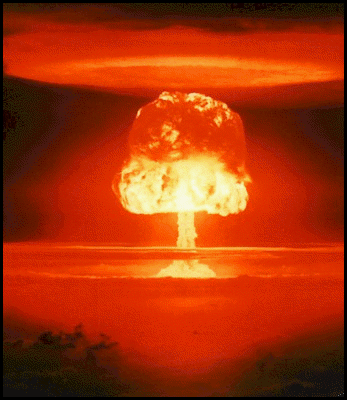
But all these above-the-ground tests --- exactly a hundred in number --- were no teapots. Some were so massive that their clouds of radiation shot up to 40,000 - 50,000 feet. With the prevailing winds, they effectively sprinkled radiation to the north --- as far as Idaho --- and east, to Boston. If you were alive in the United States at the time --- especially if you were in utero ... you got rads. Courtesy of the Feds.
The catchphrase was "Nuclear Arms for Peace," and there was nothing to worry about. As Ms. Ronald shows, in 1953, while people in the small community of St. George, Utah were being dusted with 100 times the official safe level of radiation from fallout, the Atomic Energy Commission was busy reassuring people that it was "nothing to be concerned about."
In 1957, atmospheric nuclear explosions in Nevada (with the name "Operation Plumbob") were later determined to have released enough radiation to cause up to 212,000 new cases of thyroid cancer amongst U.S. citizens, leading to as many as 21,000 deaths. This from a report issued by the National Cancer Institute in 1999.
Scientist Pat Ortmeyer wrote in The Bulletin of Atomic Scientists,
-
While the public was not warned to refrain from milk consumption and was continually reassured that fallout posed no danger, the AEC was providing advance notice, including "forecasts of contaminated areas based on meteorological data" ... but only to the National Association of Photographic Manufacturers. Why them and them alone? So that they could "anticipate local contamination and take preventive action" to protect photographic film from being ruined by radiation exposure. (The warning to the photographic industry began in 1951 -- the first year of testing in Nevada -- as a result of the Eastman Kodak Company's threat to sue the AEC over damaged film from nuclear fallout. The warnings continued throughout the atmospheric testing program but were not extended to the public at large.)
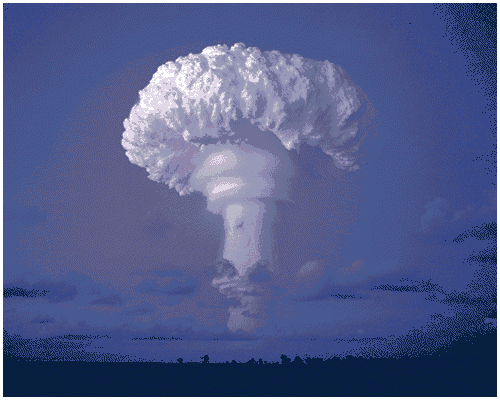
He concluded,
- We accept risk as payment for our pleasures, our comforts, and our material progress. Here the choice seems much clearer --- the terrible risk of abandoning the defense effort which is so essential under present conditions to the survival of the free world against the small controlled risk from weapons testing.
It was under his tenure at the AEC that the units of radiation --- "rads" as they were known as before --- were renamed "Sunshine Units."
Ms. Ronald has elected to concentrate on the atomic bomb tests of 1953, known as the "Upshot-Knothole" series. She gives us twelve fictional or semi-fictional characters that were in Nevada or Utah during that year's twelve atmospheric tests.
There are technicians working for the military or the AEC. There are operatives of the FBI sent to look for spies. There are soldiers who were placed, with scant protection, in dugouts near the epicenter.
There is an old cowboy who cares for the rabbits, mice, sheep, pigs and beagles (beagles!) who are to be placed directly under the area of the blast. There are pigs who are dressed in military uniforms cut to their exact size so scientists could see the effect of radiation on the skin with different colors and types of cloth (pig-skin is not that different from people-skin). There is young Liz who goes with her father to look at 700 unfortunate sheep that have been burned by the bomb they dubbed "Badger."
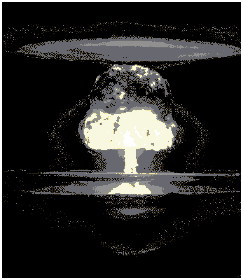
But the book takes on an urgency as our characters learn that despite what the government agencies are saying, something weird is going on. The atomic clouds are eerily beautiful: "shades of apricot and peach," and the
- deep magenta was shading into pink, while the orange fiery core pulsed and glowed ... gradually turning from orange to brown.
"Beautiful and ugly all at the same time, its top fringed with what looked like whipped cream, the infernal cloud towered above us, then began to slide away."
Ms. Ronald thus captures nicely the double-bind that the "downwinders" were in. They wanted to support the scientists' efforts to come up with weapons that would stymie the Russians. The model citizens of St. George, Utah --- all Mormons --- had faith in the government, which was, after all, "in the business of protecting its citizens, not causing them harm."
Yet these devout Mormons suddenly find themselves under "a flutter of dust, like dry falling snow on a cold winter night ... [they] taste something faintly metallic in the morning air that smells almost putrid." There had been a sudden shift in the winds over the proving grounds. Much of the fall-out and dust floated over and into St. George. It was later reported that almost half of those who lived in that community in 1953 were affected in some way or another.
The story of the Paiutes is as disturbing. In her afternote, the author tells us that the "Paiute family comes from my imagination." "Two reservations sit precisely in the middle of the worst 1953 fallout, [and] I wanted to write a chapter about downwind Native Americans."
- But I discovered that almost no one from that mid-century generation survived to middle or old age. While I talked at some length with tribal administrators and leaders in Cedar City, Utah, and on the Moapa Reservation, there was no one left for me to consult directly, and no written record of what happened there.
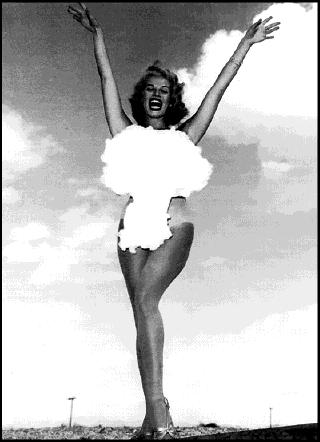
There were the other disreputable comic asides. Daring young ladies wore "bikinis," named after one of the earliest tests where a bomb cremated a whole island (and later, we were to learn, irradiated the Polynesian natives of that atoll). It became an elbow-in-the-ribs joke for young men on the beach, leering at such a bounty of flesh. Then there was Charles Mingus' fervent gospel song, "Oh Lord, Don't Let Them Drop That Atomic Bomb on Me!"
There were the jokes about our eyes glowing in the dark after we have received enough "Sunshine Units." And Ms. Ronald tells of several young ladies, dancers at the casinos, who went out to the mountains near the test area to wriggle and move to the brilliant white light given off by "Ray." (They called themselves the "Atomic Angels.")
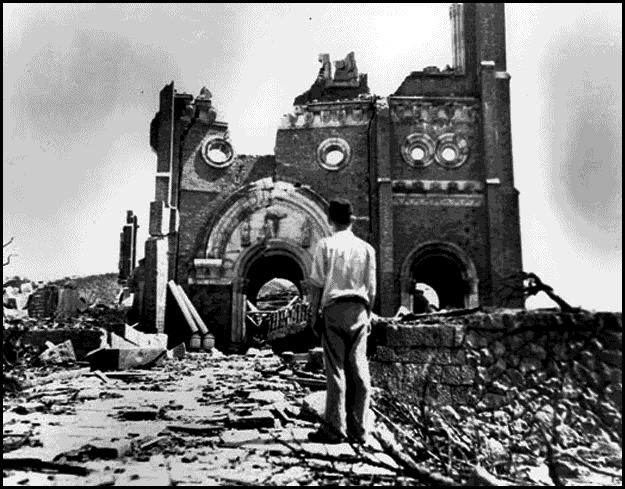
--- Lolita Lark